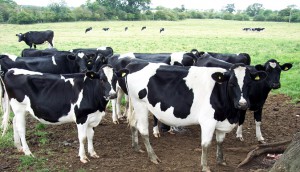Source: Zim in aggressive AI to boost cattle herd | The Financial Gazette October 12, 2017

The government last year set a target of five percent growth in the national cattle herd.
ZIMBABWE has embarked on an ambitious artificial insemination programme to boost its national cattle herd.
Artificial insemination is the process of collecting sperm from a bull and artificially depositing them into the reproductive tract of a heifer.
The process allows the germplasm from male species of superior quality to be effectively utilised.
Zimbabwe Agricultural Society chief executive officer, Anxious Masuka, last week said his organisation, in partnership with private companies, had started a livestock breeding programme under which semen extracted from hybrid bulls would be released for artificial insemination in both communal and resettlement areas countrywide.
“We are launching one of the biggest artificial insemination projects in Zimbabwe’s history. We are going… to be drawing potentially over 5 400 straws. That’s equivalent to 5 400 heifers or cows that will be serviced,” he said.
“The intention is to distribute this to deserving communities during the peak of the rainy season so we can contribute to the revitalisation of the national herd,” Masuka added.
The government last year set a target of five percent growth in the national cattle herd, from the current figure of 5,5 million to 5,8 million by the end of 2017 in a move aimed at addressing restocking challenges.
The country, which lost thousands of cattle in the past five years following consecutive droughts, has been struggling to restock due to the country’s precarious financial situation.
Deputy Agriculture Minister responsible for Livestock, Davis Marapira, recently said government was working with the private sector in financing the livestock breeding programme.
“Government is not happy with the runaway drop in our livestock population, especially cattle. The private sector, especially those companies that run abattoirs that slaughter cattle every day for commercial purposes, should partner government in the re-stocking programme because they will also be affected if the cattle population continues to drop, he said.
Zimbabwe wants to restore its status in southern Africa as a major beef producer and exporter by helping cattle farmers in both communal and resettlement areas to improve the quality and size of their herd.
This would also result in the revival of fortunes for the Cold Storage Company, whose once-thriving plants in cities such as Bulawayo, Marondera and Masvingo are now derelict owing to a dip in the country’s cattle population over the past decade and half.
Agriculture experts said the potential of artificial insemination has remained unexploited and is mainly used for exploratory purposes by research institutions.
A few African countries including Nigeria, Ethiopia, Uganda, Ghana, Botswana, Malawi, Senegal, Mali and Sudan have taken the technology to upgrade indigenous stock and to enable a limited number of commercial farmers to keep “exotic” dairy cattle breeds.
Information gathered by The Financial Gazette shows that artificial insemination has played an important role in enhancing animal productivity, especially milk yields, in developing countries that have a well-defined breeding strategy and a sound technical base to absorb and adapt the technology to meet their needs.
However, artificial insemination systems are costly to maintain and require intensive logistic and maintenance because of the need for liquid nitrogen to store semen.
Therefore, countries can maintain successful artificial insemination systems with an effective technology transfer mechanism, effectively integrated international assistance into their national germplasm improvement programmes.
COMMENTS